Top News
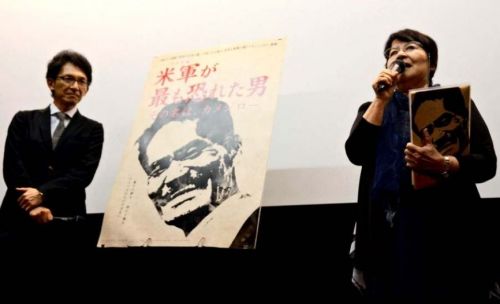
August 28, 2017 Ryukyu Shimpo
On August 26 screenings of director Takahiko Sako’s documentary Kamejiro, the man the U.S. military was most afraid of, began in Tokyo.
The film is about Kamejiro Senaga, who persisted in his stance of opposing political pressure under the U.S. occupation.
Sako has succeeded in securing Euro Space in Shibuya for screenings of his documentary during the first part of September.
Introducing his film onstage prior to the August 26 screening, Sako said, “I want people to come to know Okinawan postwar history through seeing the way Kamejiro-san lived his life, and I want to bring them to recognize various things through shedding light on current circumstances in Japan.”
Senaga’s second-eldest daughter Chihiro Uchimura joined Sako onstage.
She said that many people around her to whom she has no connections tell her how deeply they were touched by the way her father lived his life.
In addition she explained: “Only after his death did I look into [his life’s work] and understand his greatness.
My father carried the profound influence of my grandmother’s love for him throughout his life.”
Touching on the topic of construction of a new base in Henoko, Nago, and related matters, Uchimura said that Okinawa is currently experiencing hardships.
She mentioned her desire for study sessions and discussion panels to promote people’s understanding of Okinawa.
Within Okinawa, aside from being screened at the Sakurazaka Theatre in Naha, the Kamejiro documentary was also screened on August 28 and 29 at Okinawa Civic Theater Ashibina.
(English translation by T&CT and Erin Jones)
Go to Japanese
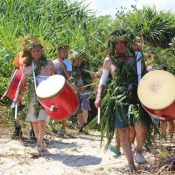
August 28, 2017 Ryukyu Shimpo Digital Edition
Kunigami – The traditional ritual “Shinugu,” which has been performed in Ada, Kunigami for over 400 years continuously, and was selected as a nationally recognized significant intangible cultural asset, was performed in Ada on August 28.
Men from both inside and outside the village wear garlands of flowers and straw, and wrap their bodies in vines and other vegetation, effectively becoming a “deity for a day.”
Only men are allowed to ascend the mountain for the ritual. At noon on the day of the festival, the men split into three groups and head up three of the village mountains: Meba, Yamanasu, and Sasa.
They repeat the chant of “Eh, Hey Hoy” and strike the ground with vegetation taken from the mountain in rhythm to a big red drum in order to collect evil and malicious spirits while parading through the town.
The women who wait back in the town strike the heads of the men with vines and reeds after they descend the mountains to drive away the collected evil spirits.
Anei Furugen 85, who beat the drum up and down the mountain, said “It’s the best.
I want to keep doing this as long as my body will allow.
” In the evening, the women form a circle and perform the dance called “Ushideku.”
(English translation by T&CT and Sam Grieb)
Go to Japanese
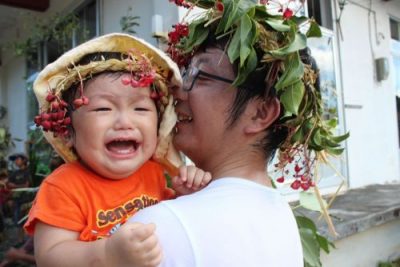
A 1-year-old child crying at the festival
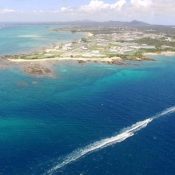
August 27, 2017 Ryukyu Shimpo
Director Keifuku Janamoto recently completed his documentary film Inochi no Umi Henoko Ourawan (Henoko and Oura Bay, the Sea of Life), which follows the lives and experiences of people living in the area around Oura Bay, where construction of a new base as a replacement facility for Futenma Air Station is moving forward.
Public screenings of the film will be held throughout Okinawa Prefecture starting in September.
The documentary’s runtime is 71 minutes.
Henoko residents who oppose the construction of the new base through sit-in protesting at the U.S. Camp Schwab gates share their thoughts in the film.
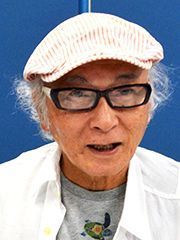
Film director Keifuku Janamoto
Images taken of Oura Bay and Henoko Village from the sky with an RC helicopter are also shown.
Janamoto stated, “Aside from introducing the conditions of the Battle of Okinawa and Ourasaki Camp, among other things, we also interviewed former Prime Minister Yukio Hatoyama, who was unable to implement the relocation of Futenma Air Station outside of the prefecture.
” He also mentioned that he hopes the viewership scope of the film extends, and that many people come to know about the nature in Oura Bay and Okinawa’s history.
There will be public screenings of the documentary at Nago City Central Library at noon on September 13 and at 1:00 p.m. on September 16.
More screenings will take place at Haebaru Cultural Center at 2:00 p.m. and again at 3:30 p.m. on September 16.
Admission is free for each screening.
The DVD of the film will be available for purchase starting in mid-September for 2000 yen.
For inquiries about the film please call +81 080 (3225) 1854.
(English translation by T&CT and Erin Jones)
Go to Japanese
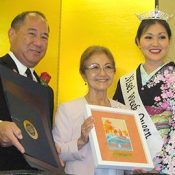
August 28, 2017 Ryukyu Shimpo
By Sadao Tome
On August 23, Okinawan American Kitty Sankey, age 69, was awarded the Nisei Week Pioneer Spirit Award for her contributions to the Japanese American community.
The award ceremony was held in Little Tokyo’s Double Tree Hilton Hotel in Los Angeles. This was part of the Nisei Week festivities for 2017.
A celebration was also held, which praised the achievements of those who received an award.
Sankey, who represented the five other awardees, said, “We plan to continue to make an effort to foster goodwill not only among Japanese Americans and Americans, but also between the U.S. and Japan.”
About 300 people participated in the celebration. Twelve people from the Okinawa Association of America gathered to celebrate Sankey’s achievement.
Sankey’s long-term contributions to not just the Okinawa Association, but also to the Japanese American community as a whole were recognized, resulting in this award.
Sankey’s parents are both from Okinawa, but Sankey herself was born in Tokyo.
She graduated Kubasaki High School in Okinawa, and after graduating University of California Los Angeles (UCLA), she earned her teaching credential from the California State University, Long Beach from which she started her teaching career.
She also took part in many Japanese American organizations to foster friendship and goodwill between U.S. and Japan.
She was involved in volunteer work as the vice president of the Japanese Women’s Society of Southern California, president of a Japanese American citizens organization in Southern California, and was part of a scholarship committee for Okinawan Americans.
Meanwhile, the Nisei Week Court, elected on August 19, also attended the celebration.
Third-generation Okinawan American Jordyn Akari Terukina, age 24, was elected as one of the princesses during the coronation ceremony.
Terukina earned her degree in Health Science from California State University, Dominguez Hills. She now works as a therapist at a hospital.
Her father is a second-generation Okinawan American.
Terukina herself was born in Gardena, California where the Okinawa Association of America office is located.
During the Nisei Week Parade on August 20, Sankey, along with the five other awardees and many supporters rode in a convertible car down Little Tokyo to spread good cheer, thereby livening up the celebration.
This year was the 18th year of presenting the Pioneer Spirit Award since it was established by the Nisei Week Foundation, which also makes it is a relatively new Nisei Week event.
But this event plays a major role and is rated highly not only among Japanese Americans, but also in the U.S. community as well.
There is no doubt that this will continue to be a highly celebrated event.
(English translation by T&CT and Chelsea Ashimine)
Go to Japanese
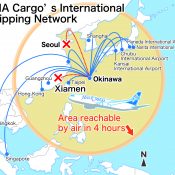
August 24, 2017 Ryukyu Shimpo
All Nippon Airways (ANA) announced on August 23 that it would be stopping 20 Saturday overnight flights which depart from their international logistics hub at Naha Airport as of October 29 due to insufficient cargo loads.
These routes, which gather cargo planes in the early hours of the morning at the hub, will be rescheduled as weekday flights.
Also, 10 weekly flights that carry cargo from Qingdao and Xiamen in China bound for the U.S. will be re-directed to Narita Airport.
Cargo flights departing from Naha Airport will be reduced to 28 per week, as part of ANA’s efforts to improve the profits of their international shipping business by reorganizing their cargo routes.
Since Naha Airport is within four hours of most major metropoles in Asia, and its 24-hour operations allow for a high level of freedom with scheduling, one of its major strengths is in high-speed deliver, since good can arrive in the evening and be delivered to their destination by the following morning.
As an international logistics hub, the airport has routes to four domestic and nine international airports, and services 120 flights over a six-day week.
Of course, many businesses do not operate on Sundays, so there are few benefits for gathering packages on Saturday for high-speed delivery.
Since the cargo-load on Saturdays is relatively small compared to weekdays, the decision was made to suspend the Saturday flights.
The routes from Qingdao and Xiamen were deemed inefficient and unnecessary, due to small cargo loads and the fact that many of the U.S. bound flights still needed to make a stop at Narita or Haneda Airports.
ANA plans to increase the number of flights that connect at Narita from Qingdao and Xiamen in their efforts to increase the efficiency of their shipping business.
Naha Airport’s cargo volume increased significantly when they began operating as ANA’s international hub in 2009, shipping 176,000 tons of cargo internationally, the fourth-largest amount for an airport in Japan behind Narita, Kansai, and Haneda Airports.
However, the air traffic out of Okinawa failed to meet initial expectations, and the operation never managed to reach profitability.
A representative from ANA Cargo, which oversaw the international shipping operation, noted, “The importance of Okinawa as the hub which connects destinations in Japan with the major Asian metropoles has not changed,” and explained that their policy would be to continue to maintain the sustainability and to strengthen Naha Airport’s shipping capabilities.
(Translation by T&CT and Sam Grieb)
Go to Japanese
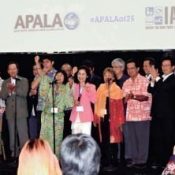
August 27, 2017 Ryukyu Shimpo
By Washington Correspondent Yukiyo Zaha
“American base expansion and the militarization of Okinawa by the Abe and Trump administrations must be stopped!”
These words, spoken by Kent Wong, head of the UCLA Labor Center and one of the founders of the Asian Pacific American Labor Alliance (APALA), in the convention hall at APALA’s 25th anniversary convention in Anaheim, California.
At the convention, which received the second delegation from the All Okinawa Council (led by Councilor Yoichi Iha), a resolution showing solidarity with the people of Okinawa, and opposing new base construction in Henoko and Takae, was passed to the applause of over 600 participants.
70% are immigrants
A similar resolution was also proposed by Wong in 2015.
His involvement in the base construction problem began when visiting Henoko on the invitation of Okinawan labor unions.
Wong was moved by the sight of continued demonstrations outside the gates of the base, day after day.
“In the home of the peace-loving Okinawans, powerful forces move to expand bases, yet the people on the small island continue to protest the Japanese and U.S. governments, two of the most powerful in the world.
Now more than ever we must show our solidarity for peace,” said Wong.
With just over 20 chapters in the U.S., APALA is a labor union that brings with it the influence of around 660,000 voices.
Around 70% of its members are immigrants from the Asia-Pacific region from countries such as China, South Korea, and Vietnam.
The Trump regime has expanded policies that oppress the rights of labor unions and immigrants, and has emboldened the actions of racist organizations.
At the convention, protesting against Trump and racism were major themes.
The convention also passed a resolution in opposition to the administrations proposed border wall.
Not someone else’s problem
Wong’s speech was echoed by many others at the convention.
Darren Shiroma, a fourth-generation Okinawan whose father’s side hailed from Nishihara, spoke after a separate meeting held by All Okinawa.
“My grandparents thought of Okinawa with pride, and it had a great influence on my values, ideals, and beliefs.
The costs of the new base construction are being paid by U.S. tax dollars.
Everyone needs to stand up and urge Congress to oppose new base construction in Okinawa.”
Edisa Adams, of Philippine and Fukuokan Heritage, felt great anger at the sexual assault by U.S. military reported at the All Okinawa meeting.
Taking with her from the meeting a DVD and pamphlet from Okinawa, Adams said she would, “tell people back home about Okinawa, and that they must act now,” and that she would strongly call Congress to action in her role as the representative of a labor union with over 10,000 members.
The Americans empathetically regarded Okinawa’s problems as “our problem as well,” as democracy’s power for action was on full display at APALA.
Councilor Iha commented, “I want to use this resolution to lobby the Japanese and U.S. governments to action.
” The power of the people crosses international borders, and is driving calls to political action in both Japan and the U.S.
(English translation by T&CT and Sam Grieb)
Go to Jpanese
August 23, 2017 Ryukyu Shimpo
On August 22 the Ministry of Defense (MOD) announced that it is moving preparations forward on a written report for submission to the Okinawa prefectural government and other local municipalities.
The report will include the use history of more than half of the U.S Northern Training Area (NTA) that was returned to Okinawa last year.
At the same time, the MOD’s representative disclosed that Japan’s Self-Defense Forces (SDF) conducted drills 13 times in the NTA, and have participated in U.S. Marine Corps training as well.
Joint-use between the SDF and Marines is progressing in the NTA.
Members of the No Helipads Takae Residents’ Society, a group consisting of Takae residents who live where the helipads are concentrated, made this appeal about the NTA land returned to Okinawa.
Concerned about the effects on noise levels and the environment, among other things, the society members requested that use of MV-22 Osprey vertical takeoff and landing aircraft be prohibited and the entire NTA be returned to Okinawa.
The MOD gave a negative response in regards to returning the entire NTA.
As for restoring the roads used for construction to their original condition in the N1 zone through national forest land, although the approval for use of this national forest land only extends to September 30, the MOD representative refused to make a clear statement and simply said that the handling of this matter has yet to be determined.
The Japanese government has already received land use history from the U.S. government, which will be necessary for the smooth implementation of a soil contamination survey on the returned land.
Once the Japanese government has the results of the survey it will provide a final report on the history and related survey results to the Okinawa prefectural government and other local municipalities.
(English translation by T&CT and Erin Jones)
Go to Japanese
August 25, 2017 Ryukyu Shimpo
(Yomitan) Yomitan Village in Okinawa Prefecture plans to open a public archive, which will be the first village-established public archive in the country.
The village aims to begin the detailed design phase for the archive in fiscal 2019 and complete the facility by fiscal 2023.
Part of efforts to develop the former site of the U.S. military’s Yomitan Auxiliary Airfield, the new facility will be located near the village office and will house documents currently located at the village library and the village history editorial office.
In addition to documents on the village’s history, the archives will also house documents relating to Chobyo Yara, Okinawa’s first governor following Okinawa’s reversion to Japan in 1972 and a native of Yomitan, including roughly 80,000 documents donated by the Okinawa Teachers’ Union.
The total cost to build the archive will be 1.2 billion yen.
Yomitan will be the second example in Okinawa of such a facility being built at the city, town or village level, the first being Chatan Town.
Yomitan Village will appoint professional archivists to the archive and plans to organize existing materials on the history of the village’s postwar recovery and put them in a digital database.
Yoshihiko Izumikawa, head of the village library, explains that once the archive is built, “If people come to the library and learn about our history, and feel that they want to learn more, they can go to the archive to do further research.
We hope to create a ‘one-stop service for knowledge’ and turn it into a center for transmission of information.
The archive will rely on disclosure of public documents, so it will promote more transparent government operation.”
Until now, the village government has collected many materials on the village’s prewar history, materials relating to migrants, and other such materials.
The data files it has already organized, including photographs, video, audio tapes and the like, exceed 300,000, and there are many more yet to be organized.
Going forward it will work on organizing materials relating to the village’s postwar history.
(English translation by T&CT and Sandi Aritza)
Go to Japanese
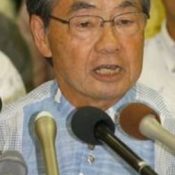
August 23, 2017 Ryukyu Shimpo Digital Edition
In preparation for the Okinawa Prefecture Nago City Mayoral Election next year on February 4, the current Nago City Mayor Susumi Inamine, 72, held a press conference on August 23 at the Nago City Labor Welfare Center to formerly declare he would run in the election to seek a third term.
Mayor Inamine raised the new base construction as the major reason for him deciding to run for mayor again.
“I’m resolved to put an end to this issue.
With the help of Governor Onaga, I will stand firmly and exercise various powers and methods,” he emphasized.
Regarding the new base construction in Henoko, Nago City or the relocation of the U.S. military Futenma Air Station, he said, “I will maintain my conviction to the very end.
I will not let them construct a new base.
” He thereby expressed that he would adhere to his commitment to oppose the base construction.
Mayor Inamine was born in July 1945 and is from Mihara, Nago City.
He graduated from University of the Ryukyus and has been working at the Nago City Hall since 1972.
He has worked as the Chief of General Affairs, Treasurer, and Superintendent of Education.
He has been the Mayor of Nago City since January 2010.
City Councilor Taketoyo Toguchi, 56, is also planning to run in the mayoral election and plans to have a press conference at the beginning of September.
(English translation by T&CT and Chelsea Ashimine)
Go to Japanese
August 24, 2017 Ryukyu Shimpo
On August 23, Professor Yasukatsu Matsushima, representing the Research Association for the Repatriation of Ryukyu Remains, published an open letter to Kyoto University regarding the holding of Ryukyuan remains.
The remains of Ryukyu people appear to have been excavated in 1928-1929 from Mumujana Grave in Nakijin by researchers from the former Imperial Universities and kept at Kyoto University.
The Association requested answers to its questions by the end of September.
The Association also requested a document concerning the remains (a list of the numbers of people whose remains are being kept).
At the interview, Kyoto University did not reveal the details of how the remains are being stored.
The open letter claims that taking remains “infringes on the United Nations Declaration on the Rights of Indigenous Peoples which violates international law” and is also “blasphemy to the deceased because it ignores traditional beliefs.
” Regarding the refusal to answer some questions on the storage situation of the remains asked by Professor Matsushima in May, Professor Matsushima criticized this saying it was a “colonialistic reaction.”
Furthermore, the Association showed that the Association of Comprehensive Studies for Independence of the Lew Chewans (ACSILs) had submitted to the Office of the United Nations High Commissioner for Human Rights in April a report requesting the return of the remains.
The Association also indicated that Taiwan University announced an intention to return remains to Okinawa.
It has requested the return of remains of Ryukyu people as well as an apology.
There are six requests including 1) the storage situation of the remains, 2) the background to the storing of the remains 3) the result of research using the remains, 4) the existence of the remains of indigenous peoples of Taiwan.
The Association also requested that a forum for dialogue between the Association and the University be established.
Professor Matsushima said, “Administrative staff at the university have received the letter.
However, at the meeting, information on the remains and the universityʻs opinion were not revealed.
We will continue to work with the prefecture’s elected Diet members and Taiwanese researchers to request a return.”
(English translation by T&CT and Megumi Chibana)
Go to Japanese
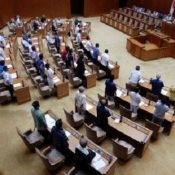
August 29, 2017 Ryukyu Shimpo
In the wake of an MV-22 Osprey vertical take-off and landing transport aircraft crashing off the coast of Australia, the Okinawa Prefectural Assembly passed a protest resolution and a written opinion demanding the withdrawal of the aircraft and U.S. Marines.
The resolution and the written opinion, proposed by the ruling parties, were adopted by a majority, including the ruling parties, neutral factions and the Komei party.
The Okinawa LDP opposed the resolution and the written opinion, and the Ishin party left the room.
On August 29, the ruling party members will visit the U.S. military headquarters in Camp Zukeran and the Okinawa Defense Bureau to hand over the resolution and the written opinion.
The LDP, which is an opposition party in the assembly, has proposed a protest resolution and a written opinion seeking an investigation into the cause of the accident.
However, the assembly did not take votes because the resolution and the written opinion proposed by the ruling parties have been adopted already.
Moriyuki Teruya, a member of the LDP, said about the ruling parties’ proposal, “When asking for the withdrawal of Ospreys, we cannot ask other prefectures to host the training for them.”
The protest resolution and the written opinion, proposed by the ruling parties, made three requests: the withdrawal of the Osprey’s deployment and the U.S. Marine Corps and the suspension of the operations of the Futenma Air Station within five years.
The resolution will be sent to the U.S. commander in Tokyo and the U.S. Consul General in Okinawa.
The written opinion will be sent to the Prime Minister, the Defense Minister and others.
Seiryo Arakaki, a member of the ruling parties, highlighted the reasons for the proposal, “Okinawan people’s fears of a crash are growing due to the accident.
” He added, regarding the current situation in which Osprey training is being forced through, “I cannot hold back my anger against the U.S. military ignoring citizens.”
Meanwhile, the opposition parties’ proposal did not progress, leaving out the request for the withdrawal of the Ospreys.
It made four requests: a thorough investigation into the cause of the accident and notifying the public about such an investigation, suspending flights until the aircraft’s safety is confirmed, transferring training of the Ospreys to outside the prefecture, and the early return of Futenma Air Station.
(English translation by T&CT)
Go to Japanese










 Webcam(Kokusai Street)
Webcam(Kokusai Street)


